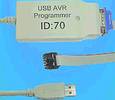

The benefits of ISP in the lab and production environments are numerous. A device can be programmed after soldering which allows 'one build, later customisation', separate test code vectors can be programmed first for function testing before programming with finished code, field upgrades are easy, code changes during development are easy - it makes sense to use ISP.
This, according to Kanda, which has developed the AVR ISP Super which is a fast and flexible programmer which uses the USB port.
Why use the USB port? More and more PCs are fitted with a USB port as standard, so connecting to a PC via the USB port not only allows one to keep your serial and parallel ports free, but one can also benefit from USB flexibility and speed. Older PCs can easily be modified using a plug in card to provide quick easy upgrades. The USB port can operate at up to 12 Mbps which gives greatly increased programming times.
As well as being ideally suited for the development environment ISP also offers added extras for use on a production line. The auto-program facility allows one to perform a complete program cycle with a single click; alternatively the auto-detection facility allows the auto-program cycle to begin automatically as soon as a device is inserted for faster programming times and less operator intervention.
One notable feature of the AVR is lockbits. These are similar to a write protect tab on a floppy disk and can be used to prevent unauthorised modification and readout of code. The AVR ISP Super fully supports programming of all lockbits, including the new extensions for self programming in the Atmega163. Some AVR devices also feature fuse bits which can be used to change the behaviour of on-board peripherals, start-up times, watchdog configuration etc. Programming of these fuse bits is also supported.
Multiple programmers
In both the development and production environments, the ability to have more than one programmer connected to a single PC is beneficial.
The ISP super allows more than one programmer can be run from one PC, and each programmer can be loaded with separate files or set to support different devices. The user interface has been carefully designed to provide 'easy operation', coupled with advanced features for the power user. Basic serial numbering facilities are provided, which is useful for quality control procedures.
For even more flexibility or to integrate into existing systems an ActiveX component is provided. This allows one to control the programmer from Visual Basic, Excel, Word or any other programming environment which supports ActiveX.
| Tel: | +27 11 887 7879 |
| Email: | [email protected] , [email protected] |
| www: | |
| Articles: | More information and articles about Sivan Electronic Supplies |

© Technews Publishing (Pty) Ltd | All Rights Reserved